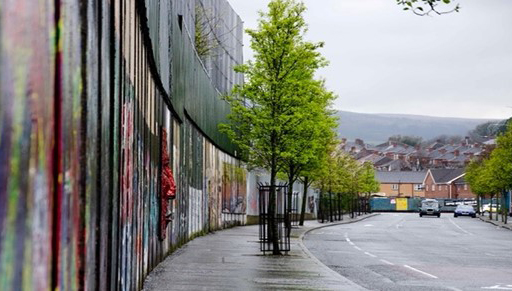3 Communities and conflict
The city of Belfast has a long history of periodic outbursts of political and communal conflict, extending back over many generations. The recent disturbances on the Shankill, for example, which you saw in the short BBC film, are just one more recent example of this kind of violence. While there are many different views on the causes of the long conflict in Northern Ireland, one of the outcomes is that over the years cities such as Belfast were divided or segregated by religion, political identity or ethnicity. During the early days of the conflict in 1969 walls were created at areas where segregated communities met – these became known as interface areas.
Like many places which have experienced political and communal conflict, Northern Ireland still has a number of these segregated communities today. Some remain separated by walls like the one above (Figure 9) which you also saw in the short film made with Matty and Dylan. This image shows part of the wall that separates the Shankill, a predominantly Protestant/Unionist/Loyalist area, from The Falls, which is a predominantly Catholic/Nationalist/Republican area. Young people from the Shankill have a range of views about the role of the wall here, as you can see in these quotes.
‘The peace wall is there to keep people from fighting. Keep them from killing each other, petrol bombing each other’s homes…. The other side would say the same’
‘It’s a burden. It’s a wall that keeps people separate. We shouldn’t have to be separated through a wall’.
Activity 8: Community divisions in your area
Note down your thoughts on the following questions about your area.
- Are there any barriers or boundaries between your and other communities in your local area? These don’t need to be physical, they could be streets you don’t walk down, shops you don’t go into for example?
- How does it make you feel when you are in another community’s area?
- How do you think people in those communities might feel when they are in your area?
- What might change how you feel?

